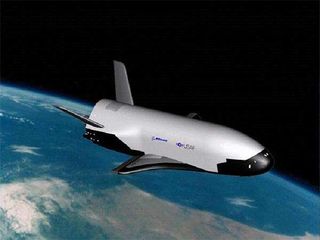U.S. Air Force Aims to Launch Space Plane Next Year

It has been a long haul to the launch pad, but the U.S. Air Force and Boeing are gearing up to loft the X-37B – an unpiloted military space plane, SPACE.com has learned.
Tucked inside the shroud of an Atlas V Evolved Expendable Launch Vehicle (EELV), the winged craft will be boosted out of Cape Canaveral, Florida, orbit the Earth and then make an auto-pilot landing in California.
The X-37B OTV-1 (Orbital Test Vehicle 1) is currently on the launch manifest for January 2010, explained U.S. Air Force Captain Elizabeth Aptekar, who works in media operations for the Secretary of the Air Force Office of Public Affairs in Washington, D.C.
"The vehicle is ready for the shipping process, which includes minor close-out activities," Aptekar told SPACE.com. "The vehicle will ship at the conclusion of the pre-ship activities ... which should be approximately 60 days before its launch date."
Years ago, the X-37B was originally slated to be deployed from the payload bay of a space shuttle. But following the tragic Columbia accident, the craft was transferred to a Delta rocket, and then later geared to be sent aloft via the Atlas V EELV.
Flying testbed
In July 1999, Boeing Phantom Works began work to develop the X-37 via a four-year cooperative agreement with NASA. In November 2002, Boeing was awarded a $301 million contract to continue the development of the X-37 flight demonstrator.
Get the Space.com Newsletter
Breaking space news, the latest updates on rocket launches, skywatching events and more!
That contract included the development of an X-37 Approach and Landing Test Vehicle to carry out a progressive series of approach and landing tests, followed by the development of an X-37 vehicle designed as an orbital flight test craft.
The vehicle's long and winding history includes an X-37 government team that was once led by NASA's Marshall Space Flight Center in Huntsville, Alabama. Also at one point, the project fell under the Defense Advanced Research Projects Agency (DARPA).
Details sketchy
While next year's flight profile remains a bit hazy, reports have the X-37B under auto-pilot control zooming into Vandenberg Air Force Base for a landing, or perhaps at Edwards Air Force Base, California.
As a reusable space plane, the intent of the craft is to serve as a testbed for dozens of technologies in airframe, propulsion and operation, and other items in the hopes of making space transportation and operations significantly more affordable.
According to earlier press releases issued by Boeing, the X-37 orbital craft is capable of circling Earth for up to three weeks.
"Potential new commercial and military reusable space vehicle market applications for these technologies range from on-orbit satellite repair to the next-generation of totally reusable launch vehicles," explained past Boeing-issued material.
[NASA's mission last month to service the Hubble Space Telescope marked the last satellite-servicing mission by the shuttle fleet.]
The intent of the X-37B mission is to try out a wide variety of experiments and technologies, including a highly durable, high-temperature thermal protection system; storable, non-toxic liquid propellants; and important new aerodynamic features - all of which are applicable to future reusable space vehicles.
The vehicle is about 27.5 feet long with a roughly 15-foot wingspan and tips the scales at about 5 tons at liftoff.
- Military Space: Securing the High Ground
- X-37 Flies At Mojave But Encounters Landing Problems
- NASA Gets Out of Satellite Servicing Business
Leonard David has been reporting on the space industry for more than four decades. He is past editor-in-chief of the National Space Society's Ad Astra and Space World magazines and has written for SPACE.com since 1999.
Join our Space Forums to keep talking space on the latest missions, night sky and more! And if you have a news tip, correction or comment, let us know at: community@space.com.

Leonard David is an award-winning space journalist who has been reporting on space activities for more than 50 years. Currently writing as Space.com's Space Insider Columnist among his other projects, Leonard has authored numerous books on space exploration, Mars missions and more, with his latest being "Moon Rush: The New Space Race" published in 2019 by National Geographic. He also wrote "Mars: Our Future on the Red Planet" released in 2016 by National Geographic. Leonard has served as a correspondent for SpaceNews, Scientific American and Aerospace America for the AIAA. He was received many awards, including the first Ordway Award for Sustained Excellence in Spaceflight History in 2015 at the AAS Wernher von Braun Memorial Symposium. You can find out Leonard's latest project at his website and on Twitter.
